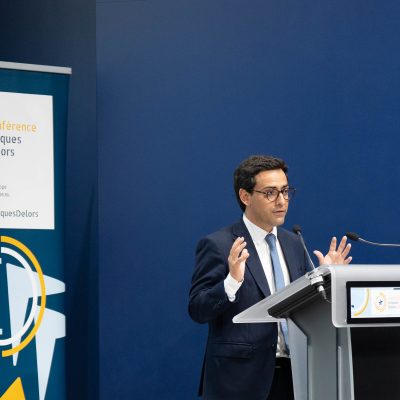Le Policy Mix de la Zone Euro
Un équilibre intrinsèquement instable

Citer cet article
Jaillet P. 2023. «Le Policy Mix de la Zone Euro, un équilibre intrinsèquement instable», Policy paper, Paris: Institut Jacques Delors, juin.
Introduction
En l’absence d’union politique, le Traité sur l’Union économique et monétaire européenne (UEM)[1] définit un modèle original de Policy-mix où les politiques budgétaires restent une prérogative des Etats membres alors que la politique monétaire unique est déléguée à la Banque centrale européenne, institution fédérale indépendante au centre de l’Eurosystème. Dans cette configuration inédite, les interactions entre la politique monétaire centralisée et les politiques budgétaires coordonnées sous régime intergouvernemental se sont dès le départ révélées complexes et l’équilibre du Policy-mix intrinsèquement instable, au gré des évènements qui ont marqué son évolution.[2]
Un autre élément important, sur le plan institutionnel, est que la politique monétaire unique concerne (par construction) la seule zone euro, alors que le cadre de coordination économique (incluant en particulier les règles budgétaires) englobe toute l’Union européenne. Ce hiatus n’a jamais été levé et s’oppose à la définition et à l’exercice d’un Policy-mix spécifique à la zone euro[3].
Ce Policy paper revient dans un premier temps sur les faiblesses du volet économique de l’UEM, son « talon d’Achille », pour reprendre les termes de Jacques Delors (2003) Il passe ensuite en revue les différentes phases du Policy mix de la zone euro, de 1999 à la grande crise financière de 2008-2009 et à la crise de la zone euro qui l’a suivie, puis de l’engagement de la BCE en 2012 à préserver à tout prix l’intégrité de la zone monétaire à la dominance budgétaire culminant lors de la crise du Covid, avant que le choc d’inflation de 2021-2022 n’impose un revirement de la politique monétaire et un rééquilibrage du Policy-mix. Enfin, la dernière section de l’article revient brièvement sur les propositions (comme celles récemment avancées par la Commission de l’UE), visant à améliorer la gouvernance économique de la zone euro.
Notes
[1] Cf. Traité sur l’Union européenne (TUE), 1993.
[2] Pour une synthèse des questions théoriques posées par le modèle, voir Kempf [2019].
[3] La reconnaissance en 2007 par le Traité de Lisbonne de l’Eurogroupe, réunissant de façon « informelle » les ministres des Finances de la zone euro, a plutôt conforté ce modèle intergouvernemental de coordination sans apporter de réponse à ce hiatus institutionnel.




